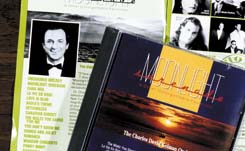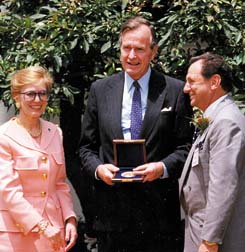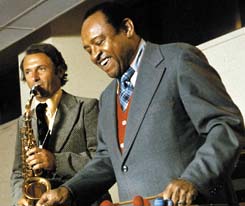Charles Kelman, MD: ophthalmologist, visionary, entertainer
A lifetime of work and success has been the reward for Charles Kelman, MD, who has pioneered advances in ophthalmology with a song in his heart and a joke on his lips.
Click Here to Manage Email Alerts
 It occurred like a scene from a movie. A medical school student coming back to the States from Europe is invited to sit in with the band on his cruise liner. An older gentleman in the audience asks the young man if he can play his saxophone. The med student thinks twice about the request, but he decides to let the old guy play his sax. And with that, ophthalmology is changed forever.
It occurred like a scene from a movie. A medical school student coming back to the States from Europe is invited to sit in with the band on his cruise liner. An older gentleman in the audience asks the young man if he can play his saxophone. The med student thinks twice about the request, but he decides to let the old guy play his sax. And with that, ophthalmology is changed forever.
Well, perhaps a few other things had to happen along the way, but that little intersection on the road of life led Charles Kelman, MD, to pursue a career in ophthalmology.
Dr. Kelman was still a medical student at the University of Geneva, Switzerland, when he was returning to the United States aboard a French ocean liner. An avid sax player, he was allowed to sit in with the band on the way home.
During his set with the band, “A well-dressed man came up to me and asked to play my sax,” Dr. Kelman said. “That was an odd request, because you don’t ordinarily let someone else play your sax. You do have to put it on your lips, after all. But I decided it would be OK. I later found out he was an ophthalmologist from Poughkeepsie, N.Y., named Sid Miller. When he found out I was a med student, he asked me to watch him perform at his practice.”
While young Charles thought this was a generous offer, he later found out Dr. Miller had his own well-meaning agenda.
“He wanted me to take over his practice someday and marry his daughter. I didn’t do either. However, we always stayed friends until he passed away a few years ago,” he said.
Beginning from his visit to Dr. Miller’s office in Poughkeepsie, on through his battle to bring phacoemulsification to the mainstream, to his continued innovations in several medical specialties to this day, Dr. Kelman has done a great deal for ophthalmology and medicine.
From sax player to visionary
Charles Kelman was born in Brooklyn, N.Y., on May 23, 1930. After graduating from Forest Hills High School and Boston’s Tufts University, he completed medical studies at the University of Geneva, Switzerland. An internship followed at Kings County Hospital in Brooklyn, and then residency in ophthalmology at Wills Eye Hospital in Philadelphia. He has been in private practice in New York since 1960.
|
|
In 1962 Dr. Kelman devised the cryoprobe, a freezing instrument for intracapsular cataract extraction. This became a widely used method for cataract removal. About 1978 it was supplanted by extracapsular cataract extraction with irrigation and aspiration, which he also helped to develop. This technique is still widely used by cataract surgeons.
In 1963, Dr. Kelman pioneered the use of cryo-repair of retinal detachments. Retinal cryopexy remains a frequent adjunct in retinal surgery.
Kelman phacoemulsification, introduced in 1967, set the stage for the move to outpatient cataract surgery in the 1980s.
In 1975, Dr. Kelman began designing IOL implants for use in conjunction with cataract surgery. Numerous companies including Allergan Medical Optics, Iolab, Alcon Surgical, Domilens and Storz Ophthalmics sought his services. By Dr. Kelman’s estimate, aggregate sales of Kelman-designed lenses by these companies total more than $340 million.
Dr. Kelman has written hundreds of articles, papers and books as well as a lay book on cataracts and an autobiography, “Through My Eyes.”
He continues to teach his surgical techniques while devoting his spare time to several new projects, including a musical, “The Right Pair Of Shoes,” and an album called “Moonlight Serenade” that was released by Columbia Records.
Eyes and ovations
|
|
At the beginning of his career, Dr. Kelman wasn’t so much revered as reviled.
“Ophthalmology has changed a lot in the past 20 years or so. The profession has changed a lot, too. At the time I really started my ophthalmology career, everyone was against change. Now change is regular — there is so much new science coming up. But when I started phaco, I constantly had to fight for it. I was labeled a charlatan,” he said.
“The older ophthalmologists were very political. Most of them didn’t use microscopes and couldn’t handle delicate needles in the eye. But since then the change has been dramatic,” he continued.
When asked if he could have predicted the change in how the world viewed him from then to now, Dr. Kelman said, “I was never confident that the change would occur, that I would go from outcast to visionary.”
Dr. Kelman’s background in show business did not particularly help him. Although his gift for music got him involved in ophthalmology, Dr. Kelman’s showman persona also made it tough for him to be taken seriously.
During a meeting of the American Academy of Ophthalmology in Las Vegas in the 1970s, Dr. Kelman happened to catch a show by Vic Damone. While watching the act he thought to himself, “I can do that.”
Dr. Kelman felt that since phacoemulsification was finally beginning to be accepted by that time, he was without a challenge. “I missed having a challenge,” he said.
When he returned to New York after that meeting, he and his office manager were driving past Carnegie Hall. “I said to my office manager, ‘Joe, book Carnegie Hall for me for next year.’ A little while later, after I had forgotten about saying that, he came to me and said he had reserved the hall. Apparently he thought I was planning on holding a medical lecture there.”
With a little under a year to go, Dr. Kelman began to brush up on his music and stage performance for the show, which would include singing and sax playing.
About a month before the show, Dr. Kelman tried out his act at his tennis club in front of notables that included Barbara Walters. In his own words, he bombed.
However, his act shaped up after he added some comedy to the routine. Since then he has entertained on “The Tonight Show starring Johnny Carson,” “Barbara Walters,” “Merv Griffin,” “Late Night with David Letterman” and “Oprah.” He has appeared in concert as a musician with Lionel Hampton and Dizzy Gillespie and has performed in concert at Carnegie Hall, in Las Vegas and Atlantic City, with James Darren, Regis Philbin and others.
“So while I was trying to convince ophthalmology that [phaco] was good, I was also doing comedy in Las Vegas and Atlantic City, opening for big names like Glen Campbell and The Spinners. This gave ophthalmologists just another reason not to trust me,” Dr. Kelman said.
Although it has been about 15 years since he has performed live regularly, he said recently someone dug up an old tape of him performing and asked him to do another show.
“I’m thinking about it,” he said.
More on the way
Entertainment aside, Dr. Kelman has brought much to ophthalmology.
When he first described his design for an anterior chamber IOL, there was a bit of resistance.
“At the time, no one wanted to believe what I thought of could work,” he said. Some other types of anterior chamber lenses had caused serious tissue reactions. “However, the only AC lenses that have been approved since then are all based on my original designs,” he said.
|
|
While the open-loop anterior chamber lens and phacoemulsification are the inventions Dr. Kelman is most well-known for, he has not stopped developing ideas.
Most recently, he has been working on a system to allow most eye doctors to dispense glasses, which is often not a cost-effective practice component for ophthalmologists.
His idea lowers the overhead for physicians while keeping spectacle revenue up. The process entails using a computer to offer patients a variety of spectacle choices. A photograph of the patient is placed in the computer, and the patient can scroll through a menu of frames that will appear on his or her computer-generated face. The ophthalmologist does not need to rely on a comanaging optometrist or optician and is saved from having to maintain a supply of sample frames.
The company that approached him with the idea is called Voyant.com.
“I think that will revolutionize dispensing. That will help maintain income without the overhead,” he said.
At the 2001 American Society of Cataract and Refractive Surgery meeting, Dr. Kelman first presented a new anterior chamber lens called the Kelman Duet implant. This is a two-piece system in which the haptics are placed in the eye through a 1- to 1.5-mm incision, then a tightly rolled optic is inserted through the same incision and dropped into the haptic. Tekkia Inc. is making the lens.
Then, Dr. Kelman described a procedure he developed not for ophthalmology but for oncology, for removing 2-mm cancer deposits in the human body, which are often too small to be removed. In his technique, a 5-mm area around the cancer area is frozen, and then the frozen tissue is emulsified using ultrasound.
The new development thus revisits two of his earliest innovations in ophthalmology, the use of freezing and ultrasound technologies.
Dr. Kelman’s idea has been praised by several thoracic surgeons, and financing has been secured to make the technology available to developing countries. He received a standing ovation after his presentation on the topic.
The future
|
|
So what does the 71-year-old visionary think about the next 20 years of ophthalmology? He thinks ophthalmology will find cures for many of its diseases and solutions for many of its problems, but not all of them.
“I think we’ll solve the problem of accommodation after cataract surgery,” he said. “I have a unique idea for the patient to see near and far. I haven’t had time to pursue it, but I hope to soon.”
Dr. Kelman said he also gives credit to the designs of accommodating IOLs currently in development.
“I think we’ll solve the problem of macular degeneration, too,” he said.
However, he thinks cures for other diseases may be beyond the 20-year horizon. He does not have much hope that retinitis pigmentosa, for instance, will be cured. He believes the genetics of the disease will take a long time to sort out.
“I think glaucoma will be better controlled, but I don’t see a cure. I think some glaucomas can be prevented, however, such as narrow-angle glaucoma. But I believe the disease is more a structural problem than anything else,” he said.
Dr. Kelman does not see a continuation of the boom that refractive surgery has seen at the turn of this century.
“The procedure has pushed doctors into becoming super-businessmen. LASIK, at present, is a good money-making venture. But as more doctors enter the market, the price will continue to decline, and it will be less economical for surgeons to do laser refractive surgery. It’s a temporary business model that will ease up as more competitors get into it,” he said.
On the other hand, he said he doubts that ophthalmology will see a return of the pure physician who sacrifices all for his patient.
“It is becoming rarer and rarer. Specialists have replaced the old country doctor,” he said.
Looking over his career past and present, Dr. Kelman proudly said, “I’m pleased I was given the genes to want to experiment and try new things. I’m pleased to see so many people have taken my ideas and improved on them. Ophthalmology is a field I really love. I may have given some to ophthalmology, but it’s given a lot back to me.”
For Your Information:
- Charles Kelman, MD, can be reached at 220 Madison Ave., New York, NY 10016-3422; (212) 736-9696; fax: (212) 736-2118.





